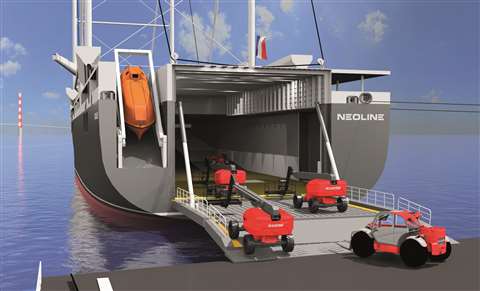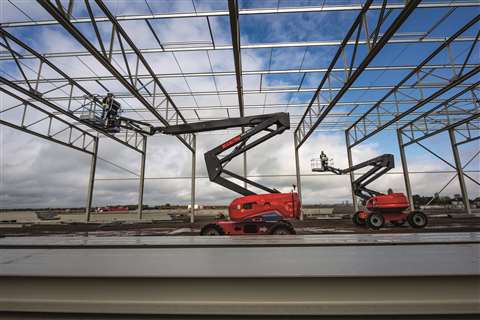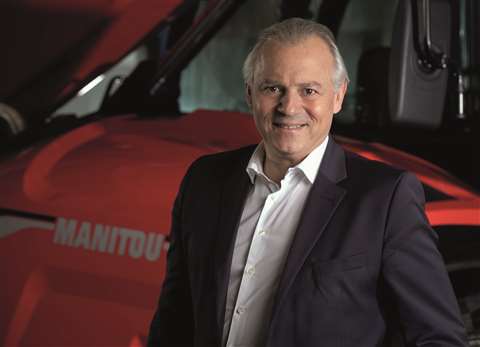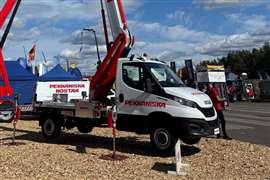Interview: Manitou Group committed to carbon reduction
03 August 2021
Manitou Group’s president and CEO Michel Denis disusses low-carbon and sustainability initiatives with Access International’s Euan Youdale.
The Manitou Group officially presented its corporate social responsibility (CSR) vision through its first virtual On the Way Up! presentation in June 2021, which is set to become an annual event. The French aerial lift and telehandler manufacturer outlined the four pillars of its CSR strategy as ethics and human beings, the circular economy, safety and working conditions and a low-carbon trajectory.
Access International spoke with Manitou’s president and CEO Michel Denis about this latter point following the online event. Complementing that green objective is the company’s New Horizons 2025 roadmap, launched in January 2021, that will see a €460 million investment to help it achieve its goals.
Denis said about the initiative, “2020 marked the world by a health and then economic crisis of unknown magnitude. Throughout the year, the group focused on protecting its employees, adapting its operations, optimising customer relations and its financial performance.”
He enthused, “We start 2021, reorganised and reshaped, with a new roadmap full of ambitions and challenges. CSR is completely imbedded in all processes, visions and our progress and what we want for our customers.”
“The vision of the whole group is CSR. Our mission as a group is to improve working conditions and improve safety and performance, while protecting the people and their environment.”
Denis explained that the company’s goal of drastically reducing its carbon footprint is not just set in the production process and low emission equipment. It is also in the procurement of materials and components, as well as how the equipment is used once delivered to the customer.
 Manitou’s On the Way Up! corporate social responsibility (CSR) first-ever virtual event
Manitou’s On the Way Up! corporate social responsibility (CSR) first-ever virtual event
Investing in Manitou’s future
Starting with the areas that Manitou can directly control, Denis claims that it will move quickly to meet its targets.
He commented, “We are investing in our manufacturing facilities to reduce our carbon footprint, but we are also investing a lot in research and development for new ranges to move to low emission products.”
In the next five years 40%of all the equipment that Manitou produces, across its product ranges of telehandlers, MEWPs, skid steers, forklifts and wheel loaders, will be low emission equipment. In the MEWP segment, all new projects will be based around the development of electric-powered models.
Denis explained, “We will continue to offer the existing [diesel] range. If you want a [diesel] boom today or tomorrow then we will provide it, and for 10 or 15 years, however long the need for diesel remains. But we will not spend any more in development. All new models will be 100% electric.”
The company stated that commitment across its range is massive in terms of investment that will see the company’s low emission Oxygen series, first launched at Bauma in 2019, greatly expanded.
During Bauma, the company announced its Build the Future project with the introduction of its first electric-powered rough terrain boom, the prototype MT 625 e electric compact telehandler and the hybrid MRT 2550 telehandler. Going forward, the Oxygen brand name will include all low emission equipment, across all product types.
One of Manitou’s firm plans is to launch the 625 e as a production model at the end of 2022. Electrifying the entire telehandler range is significantly more difficult than doing so across the RT MEWP series but the company will start with the rotating MRT range, although the process will not be immediate.
Denis admitted that it is not just the technology that is a challenge, “It will take more time because depending on the country and business, for example farmers, the availability of electricity will take longer.”
 Manitou have partnered with NEOLINE, which involves the transport of aerial platforms and telehandlers to the North American market
Manitou have partnered with NEOLINE, which involves the transport of aerial platforms and telehandlers to the North American market
Manitou’s pioneering Reduce programme
Another major, and related initiative at the company is its Reduce programme, which forms the backbone if the R&D roadmap. The programme includes groundbreaking initiatives like the online fuel consumption calculator, which allows companies to estimate consumption, CO2 emissions and the financial gain achieved in customising work cycles to specific activities.
Collecting this type of information also helps the team to reduce total cost of ownership (TCO) across the machine and its use, from fuel consumption to oil changes, consumables and the cost of parts. Ultimately, the idea is to understand the lifetime of the machine at the design stage.
Denis uses the recent launch of its newly updated Vision and Vision Plus MRT series as an example and stated, “The TCO of the new MRT is a breakthrough. When you look at the cab, you look at the economy, you look at the security and the performance.”
 Manitou’s electric RT boom lift, the Oxygen-series 200 ATJ e, will be followed by a complete series
Manitou’s electric RT boom lift, the Oxygen-series 200 ATJ e, will be followed by a complete series
Advantages of lithium-ion over lead acid batteries
While the company has chosen lead acid batteries for its first electric models, including its first all-electric rough terrain boom lift, the 20m working height Oxygen-series ATJ 200 e, launched at Bauma 2019, the future focus will be on lithium-ion batteries.
In accordance with the plan Manitou has struck a supply deal with a lithium battery provider that addresses the thorny issue of recycling lithium batteries, with an agreement that will see all batteries reconditioned for further use beyond the lifetime of the machine.
Denis said, “We use lead acid at the moment because we have used it for the last 25 years. We have produced electric machines for a long time at Manitou, we have some indoor MEWPs and forklifts that are electric like everyone in the market.
“But the lithium-ion battery will be important in the future. For outdoor machines we need the capacity, a strong performance and volume of energy per cubic centimetre. So when you speak about telehandlers, you need to go to lithium-ion for more capacity, with the same volume.”
The second advantages of lithium over lead acid batteries is the well-documented recharging capabilities, in that lithium batteries can be partially charged at any time.
Denis added, “When we talk about agility for our customers for example in a warehouse you can easily organise charging of each machine. But when you speak about someone on a worksite or on a farm, if you have half an hour to recharge you can do it with lithium. If you did that with a lead acid battery you would kill it in two years. For those two reasons then 90% of rough terrain products will be lithium-ion.”
A hugely important area of consideration is in the machine’s use after its delivery to the customer. In fact, 80% of the emissions connected to a machine come after it has been manufactured. Around 9% comes from the raw materials and purchasing stage, up to its arrival at Manitou’s factories and just 2% of emissions from the lifetime of a machine are derived from the production process.
For this reason the company is concentrating on its carbon pathway goal, which will mean 40% of all future products will fall under the company’s low emission Oxygen range.
Denis said, “We have to do even more if we want to address the impact of the usage, which is absolutely massive. We are attacking the usage in many different areas, around the training of people, new products, the consumption of existing machines and reworking old machines with new solutions. So we are looking at a 360 degree programme for the use of the machine.
“It is not just about launching some new electric equipment, it has to be about 360 degree eco-driving data. And, how we use the data as a powerful tool to reduce our impact, what we do to help people to reduce their impact through new projects and behaviours.”
 Manitou president and CEO Michel Denis pointed out, “The vision of the whole group is CSR”
Manitou president and CEO Michel Denis pointed out, “The vision of the whole group is CSR”
Cutting-edge hydrogen innovation lined up
One example of the many steps the company is taking is its Ecostop, which automatically stops the engine and the associated timer when the machine is idling. An example of a much larger step will be the launch of a prototype hydrogen-powered telehandler in 2022.
The company is not ready to release any information regarding the specifications of the prototype, but it will be the result of collaborations with partners based in Western France that specialise in hydrogen technologies.
Denis explained, “I think hydrogen has the same future as lithium, as long as a society we find solutions to make green hydrodgen. We have to be careful not to hide behind hydrogen if it is not green, it could be a disaster if you do not work on the entire chain.
“It could be a strong solution, when you look at it as a pure power. There is the storage issue, under high pressure. But it is just a tank, and so it is easy to maintain and recycle. There are many advantages but the price and the production today remain topics that we have to work on.”
STAY CONNECTED



Receive the information you need when you need it through our world-leading magazines, newsletters and daily briefings.
CONNECT WITH THE TEAM












